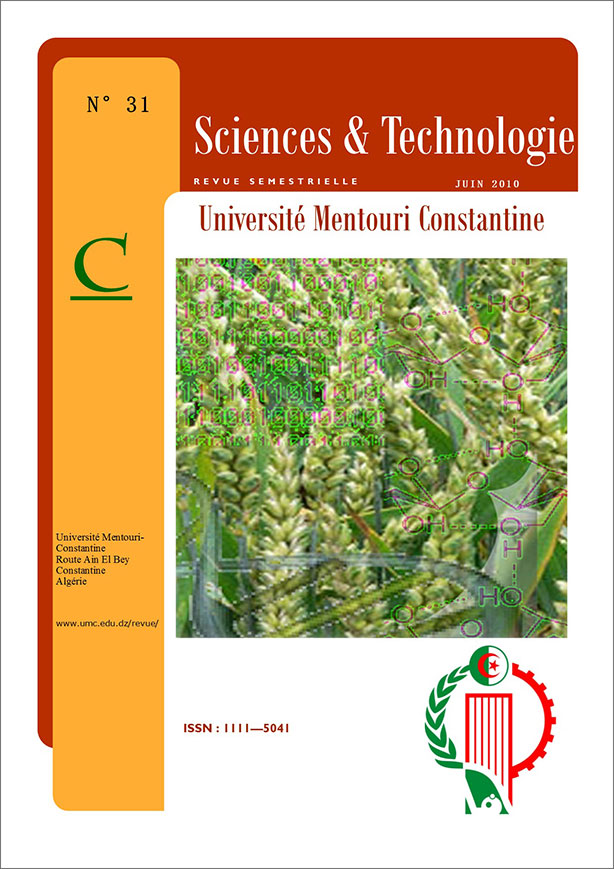Influence de la saison et de la race du cheval de course sur le profil minéral sérique dans la région d’El-Eulma- SETIF
Mots-clés :
cheval de course, déséquilibre nutritionnel, profil minéralRésumé
Le cheval de course est un animal monogastrique duquel on exige de fournir un effort considérable, pendant une période relativement longue de savie. Par conséquent, un grand nombre de facteurs peuvent provoquer un déséquilibre nutritionnel et métabolique à n’importe quelle période de sa vie.
En Algérie, la pathologie des équidés est mal prise en charge. Les déséquilibres nutritionnels ne sont incriminés que lors d’une baisse de forme ou d’une chute des performances du cheval.
Ce travail a été réalisé dans le but de faire une étude comparative détaillée entre les chevaux de la race pur-sang Anglais et ceux de la race pur-sang Arabe. Cette étude a porté sur l’investigation de
l’influence de la saison sur le profil minéral sérique (Ca, P, Mg, Na, K, Cl, Fe).
Références
-Fortier, G.; Bermann, F.; Couroucé, A. Approche hématologique et biochimique dans le suivi médico-sportif du cheval athlète : intérêt et limites.
- Bilan à l’exercice et à l’entraînement. Prt. Vet. Equine., 32(numéro spécial) (2000), 343 – 348.
-Gray, J.; Harris, P. ; Snow, D. ; Preliminary investigations into the calcium magnesium status of the horse. In: «Animal Clinical BiochemistryThe future» Blackmore, D.J. Cambridge
University Press, Cambridge (1988), 307 – 317.
-Vervuert, I.; Coenen, M.. Wedemeyer, U.; Chrobock, C.; Harmeyer, J.; Sporleder, H.P. Calcium homeostasis and intact plasma parathyroid hormone during exercise and training
in young standarbred horses. Equine Vet. J. 32 (2002), 808 – 813.
-Meyer, J.; Heilmann, M.; Perez, H.; Gomda, Y.;
Investigations on the post prandial renal Ca-P and Mg-excretion in resting and exercising horses. Proceedings of 11
th equine Nutr. Physiol. Symp. Oklahoma (1989), 133 – 138.
-Briggs, K. Nutrition, Amazing minerals. http:// www.thehorse.com/0398/nutrition.html. (1998).
-Harris, P.A.; Marlin, D.J.; Scott, C.M.; Harris, R.C.; Mills, P.C.; Michell, A.R.; Orme, C.E.; Roberts, C.A.; Schroter, R.C.; Marr, C.M. Electrolyte and total protéin changes in non heat
acclimated horses performingtreadmill exercise in cool (20 degrees C/40% RH), hot, dry (30 degrees C 40% RH) or hot, humid (30 degrees C/80% RH) conditions. Equine Vet. J. 20 (1995), 85 – 95.
-Carlson, J.P. Hematology and body fluids in the equine athlete: a review In: «Equine Exercise Physiology 2» Gillespie, J.R. and Robinson, N.R. ICEEP Publications, Davis California (1987), 393 – 425.
-McKeever, K.H.; Scali, R.; Geiser, S.; Agan, S.;Guïrnalda, P.D.; Kearns, C.F.; Dinock, A.N. Training-induced alteration in renal function in horses (Abstract). Med. Sci. Sports Exerc. 31 (suppl) (1999), 323.
-Freund, B.J.; Wade, C.E.; Claybough, J.R. Effects of exercise on atrial natriuretic factor zelease mechanism and implications for fluid homeostasis. Sports Med. 6 (1988), 365 – 376.
-Johnson, P.J. Electrolyte and acid-base disturbances in the horse. Veterinary Clincs of North America. Saunders, W.B. Company. Philadelphia, London, Toronto, Montreal,
Sydney, Tokyo. 11 (1995), 491 – 514.
-Johnson, P.J.; Goetz, T.E.; Foreman, J.H. Effect of the whole-body potassium depletion on plasma, erythrocyte and middle gluteal muscle potassium concentration of healthy adulte horses. Am. J. Vet. Res. 52(1991), 1676 – 1683.
-Cohen, N.D.; Russel, A.J.; Lumsden, J.H.; Cohen, A.C.; Grift, E.; Lewis, C. Alterations of fluid and electrolyte balance in thoroughbred race horses following strenuous exercise during training. Can. J. Vet. Res. 57 (1993), 9 – 13.
-Johnson, P.J. Physiology of body fluids in the horse. Veterinary Clincs of North America. Saunders, W.B. Company. Philadelphia, London, Toronto, Montreal, Sydney, Tokyo. 14(1998), 1 – 22.
-Butudom, P.; Barnes, D.J.; Davis, M.W.; Nielsen, B.D.; Eberhart S.W.; Schott, H.C. Rehydratation fluid tempurature affects voluntary drinking in horses dehydrated by furosemide
administration and endurance exercise. The Veterinary Journal. 167 (2004), 72 – 80.
-Maughan, R.J.; Shirreffs, S.M. Recovery from prolonged exercise: restoration of water and electrolyte balance. Journal of Sport Science. 15 (1994), 297 – 303.
-Shirreffs, S.M.; Taylor, A.S.; Leiper, J.B.; Maughan, R.J. Post-exercise rehydration in man: effect of volume consumed and drink sodium content. Medicine and Science in Sports and
Exercise. 28 (1996), 1260 – 1271.
-Lawrence, L.A. The use of non-invasive technique to estimate bone mineral content and bone strength in the horse. M.S. Thesis. University of Florida. Gainesville. U.S.A. (1986).
-Bost, J.; Fontaine, M.; Jean-Blain M.; Lapras, M.; Magat, A. Evaluations de certains constituants de sang chez des chevaux cliniquement normaux. Ann. Rech. Vet. 1 (1970),
– 91.
-Gautter, A. Les examens de laboratoire en pratique vétérinaire. Science Agricole Editeurs (1979), 151 pp.
-Fontaine, M.; Cadore, J.L. Vade-mecum du vétérinaire. 14eme Edition. Editions Vigôt Frères, France (1995), 1672 pp.
-Susan, E.; Aiello, B.S. Le manuel vétérinaire merck. 8
eme édition. Editions Merck & CO., INC. Whitehouse Station, N.J., U.S.A. (2002), 2297 p.
-Barrey, E. Manuel pratique – Maladies des chevaux. Editions France Agricole (1994), 279 pp.
-Rico, A.G.; Braun, J.P.; Benard, P.; Bardites, J.; Thouvenot, J.P.; Periquet, B.; Plantavid, M. Biochimie sérique du poney. Ann. Vet.9(1978), 393 – 399.
-Henry, R.S.; Carlson, P.C. How to use the routine serum biochemical profile to understand and interpret acid-base disorders in the horse. American Association of Equine Practioners. Proceedings. 47(2001), 257 – 261.
-Taylor, L.E.; Ferrante, P.L.; Kronfeld, D.S.; Meacham, T.N. Acide-base variables during incremental exercise in sprint-trained horses fed a high fat diet J. Anim. Sci., 73(1995), 2009 – 2018.
-Sylvie, M.; Marie-José, S.; Etienne, B.; Francois, G.; Paul, D. Valeurs usuelles en biochimie clinique vétérinaire. Polycopié, Laboratoire de biochimie. ENV Lyon, France. (1982), 63 pp.
-Tasker, J.B. Fluids and electrolytes studies in the horse: blood values in 100 normal horses. Cornell. Vet. 16 (1966), 67 – 75.
-Kraft, W.U.; Dürr, U.M. Kompendium der klinischen. Laboratoriumsdiagnostik bei Hund, Katze, Pferd. Verlag M&H Scharper, Hannover 37 (1981), 127 – 131.

